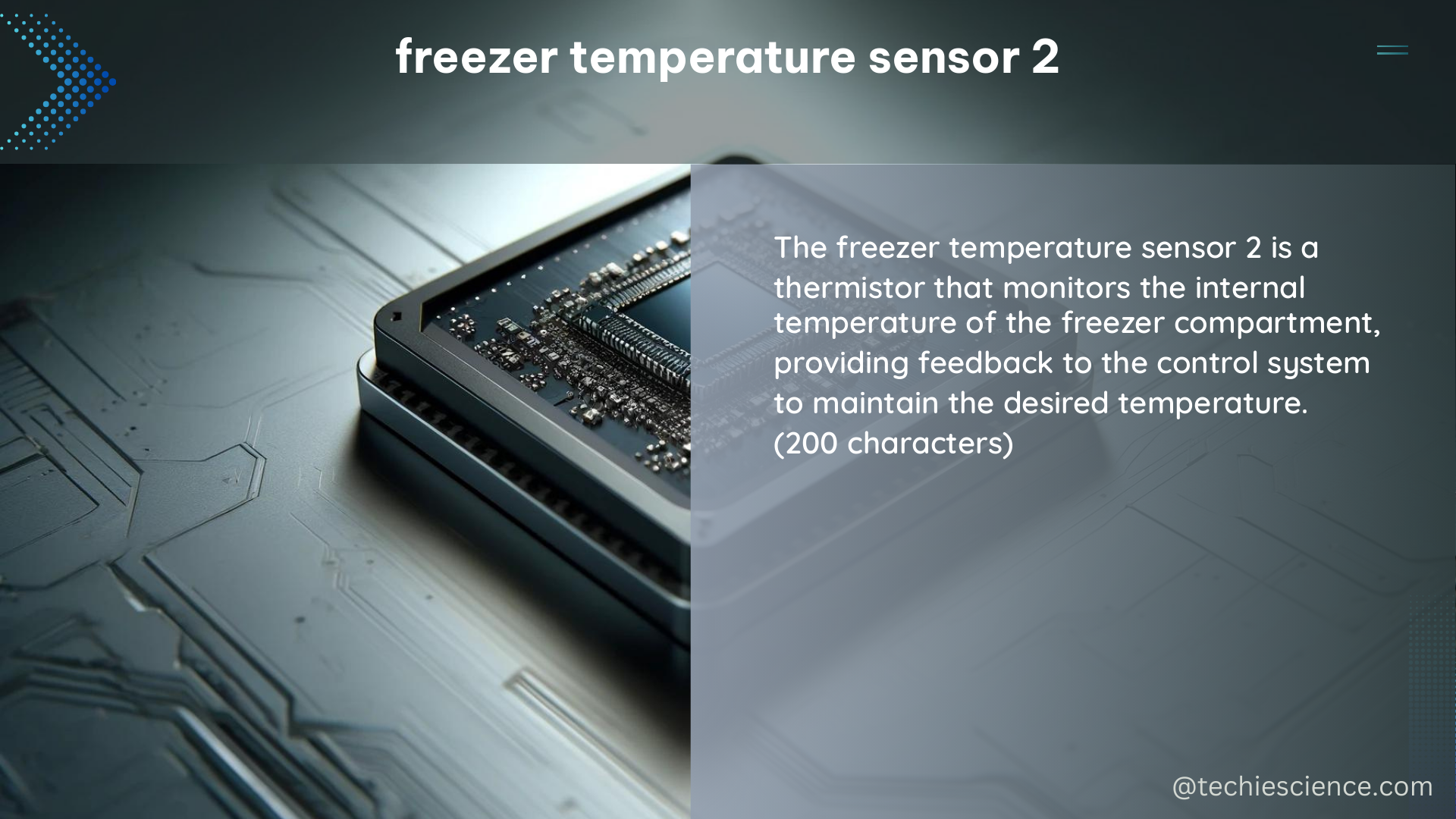Freezer temperature sensor 2 is a critical component in maintaining the optimal temperature for food preservation and safety. It is designed to measure the temperature inside the freezer and provide accurate data to ensure that the freezer is functioning correctly. The temperature sensor is typically a thermocouple or a resistance temperature detector (RTD), such as a Pt1000 RTD sensor, which is known for its high accuracy and stability.
Technical Specifications of Freezer Temperature Sensor 2
The technical specifications of freezer temperature sensor 2 can vary depending on the manufacturer and the specific model. However, some common specifications include:
| Specification | Range |
|---|---|
| Temperature Range | -200°C to 650°C |
| Accuracy | ±0.1°C to ±1°C |
| Response Time | Less than 3 seconds |
| Detection Limit/Range | 1nM to 100mM |
| Sensitivity | 1~4pA/nM |
| Drift | None to some |
Additionally, the sensor may be temperature-dependent, with a temperature acceleration factor from Tt to Ts, and may be affected by physiological interference.
Measurable and Quantifiable Data

When it comes to measurable and quantifiable data, freezer temperature sensor 2 can provide valuable information such as:
- Current Temperature: The sensor can measure the current temperature inside the freezer, allowing you to monitor the temperature in real-time.
- Minimum and Maximum Temperature: The sensor can record the minimum and maximum temperatures reached within a specified time frame, providing insights into the freezer’s performance.
- Temperature History: The sensor can log the temperature history, enabling you to analyze temperature fluctuations and identify any anomalies.
- Temperature Fluctuations: The sensor can detect and record any temperature fluctuations, which can be crucial in maintaining the optimal temperature for food preservation.
This data can be used to monitor the freezer’s performance, detect any issues, and ensure that the food is being stored at the correct temperature.
Calibration of Freezer Temperature Sensor 2
Calibration of the freezer temperature sensor 2 is essential to ensure its accuracy and reliability. This process involves adjusting the sensor’s output to match a known temperature standard, such as a reference thermometer or a temperature-controlled bath. Calibration can be done manually or using pre-calibrated temperature inputs, such as those provided by World Precision Instruments.
The calibration process typically involves the following steps:
- Preparation: Ensure that the freezer temperature sensor 2 and the reference thermometer are placed in the same temperature-controlled environment, such as a temperature-controlled bath or a calibration chamber.
- Comparison: Compare the readings from the freezer temperature sensor 2 and the reference thermometer at multiple temperature points within the sensor’s operating range.
- Adjustment: Adjust the sensor’s output to match the reference thermometer’s readings, either manually or using pre-calibrated temperature inputs.
- Verification: Verify the sensor’s accuracy by comparing its readings to the reference thermometer at multiple temperature points.
Proper calibration of the freezer temperature sensor 2 is crucial to maintain the accuracy and reliability of the temperature measurements, which is essential for ensuring the safety and quality of frozen food.
Factors Affecting Freezer Temperature Sensor 2 Performance
The performance of the freezer temperature sensor 2 can be affected by various factors, including:
- Environmental Conditions: The sensor’s accuracy and stability can be influenced by factors such as ambient temperature, humidity, and pressure.
- Sensor Placement: The location of the sensor within the freezer can impact the accuracy of the temperature measurements, as it may not be representative of the overall temperature distribution.
- Sensor Aging: Over time, the sensor’s performance may degrade due to factors such as wear, corrosion, or drift, which can affect the accuracy and reliability of the temperature measurements.
- Electromagnetic Interference: The sensor’s performance can be affected by electromagnetic interference from nearby electrical equipment or power lines, which can introduce noise or errors in the temperature measurements.
To mitigate these factors and ensure the optimal performance of the freezer temperature sensor 2, it is essential to follow the manufacturer’s recommendations for installation, maintenance, and calibration.
Conclusion
Freezer temperature sensor 2 is a critical component in maintaining the safety and quality of frozen food. Its technical specifications, measurable data, and calibration requirements are essential factors to consider when selecting and using this type of sensor. By understanding the capabilities and limitations of the freezer temperature sensor 2, you can ensure that your freezer is operating at the optimal temperature, protecting the integrity of your frozen food.
References:
– Renesas Electronics Corporation. (n.d.). JEDEC STANDARD. Retrieved from https://www.renesas.com/us/en/document/gde/jedec-definition
– Federal Aviation Administration. (2006-08-25). Compilation of 14 CFR Parts 400-460. Retrieved from https://www.faa.gov/about/office_org/headquarters_offices/ast/licenses_permits/media/Part_400_compilation.pdf
– ACS Publications. (2022-10-12). Self-Powered Edible Defrosting Sensor. Retrieved from https://pubs.acs.org/doi/10.1021/acssensors.2c01280
– World Precision Instruments. (n.d.). TBR4100/1025. Retrieved from https://www.wpiinc.com/media/wysiwyg/pdf/TBR_IM.pdf
– Digital Commons FIU. (2020-03-17). Novel Passive RFID Temperature Sensors Using Liquid Crystal. Retrieved from https://digitalcommons.fiu.edu/cgi/viewcontent.cgi?article=5698&context=etd

The lambdageeks.com Core SME Team is a group of experienced subject matter experts from diverse scientific and technical fields including Physics, Chemistry, Technology,Electronics & Electrical Engineering, Automotive, Mechanical Engineering. Our team collaborates to create high-quality, well-researched articles on a wide range of science and technology topics for the lambdageeks.com website.
All Our Senior SME are having more than 7 Years of experience in the respective fields . They are either Working Industry Professionals or assocaited With different Universities. Refer Our Authors Page to get to know About our Core SMEs.